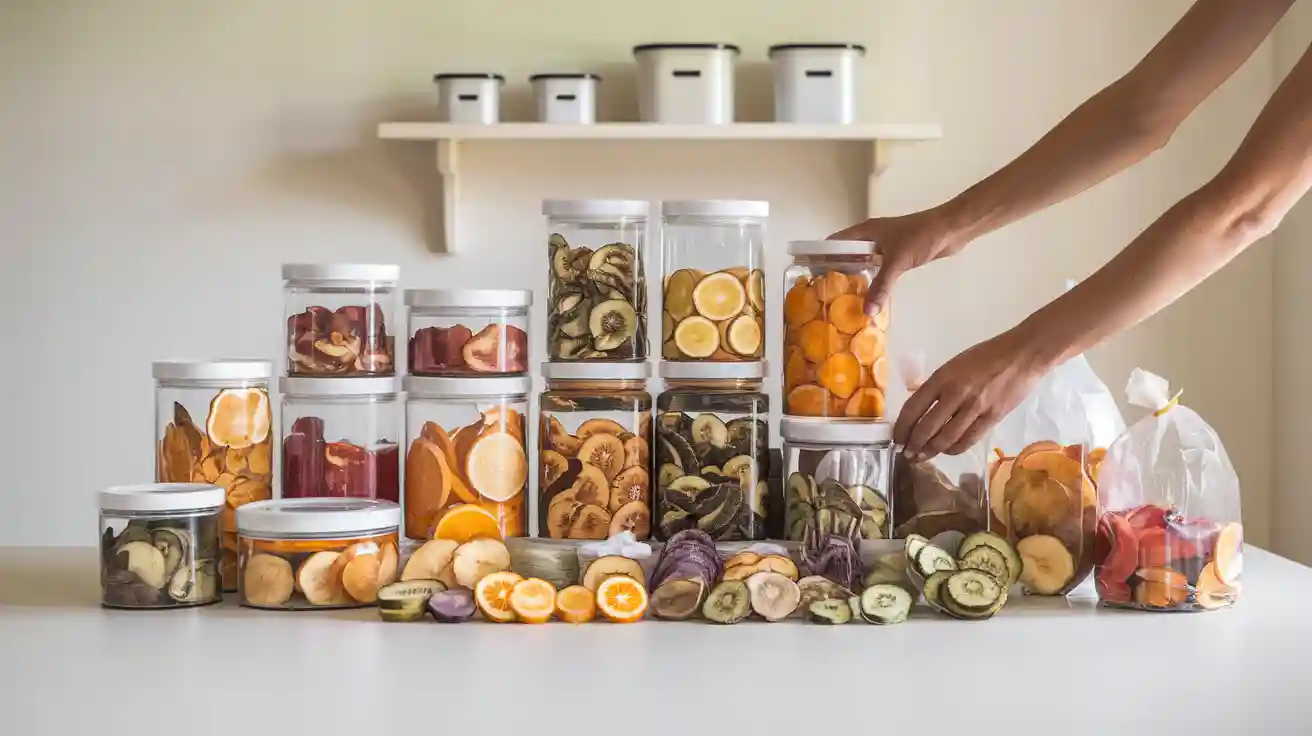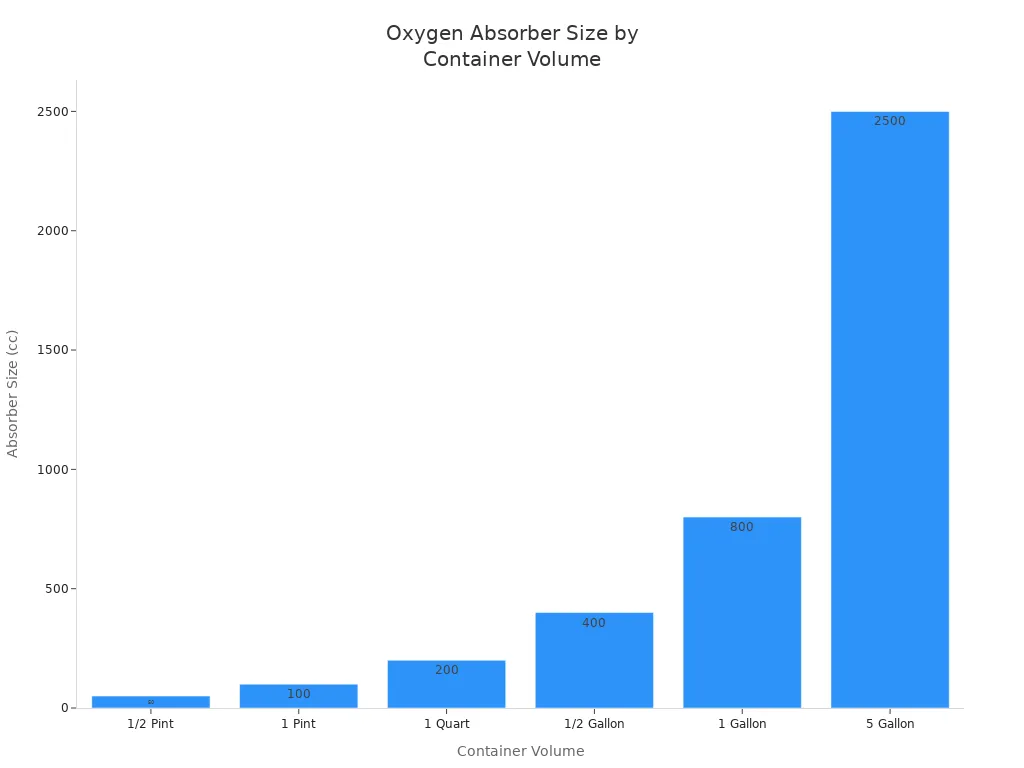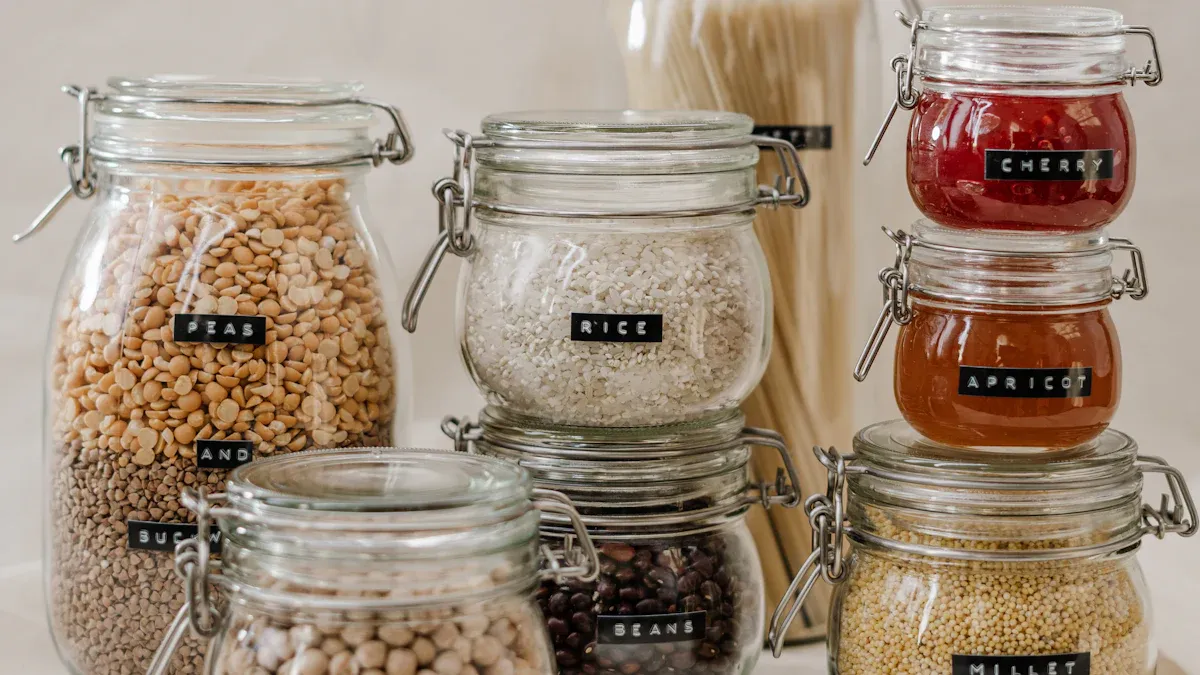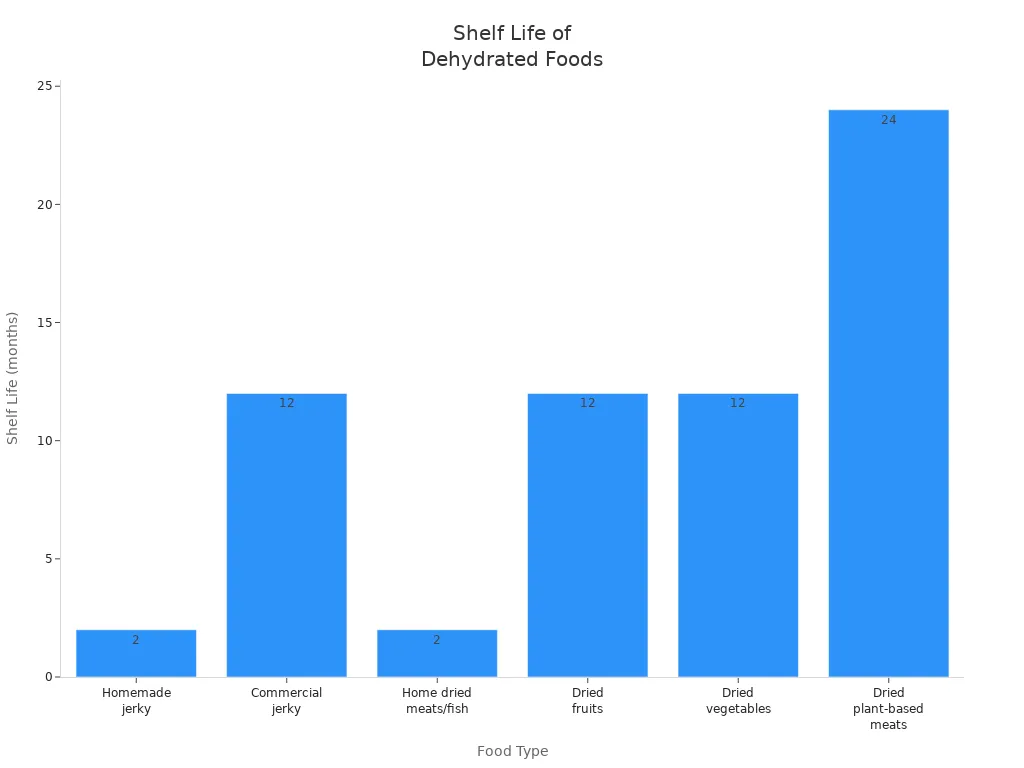
You want your dehydrated foods to last as long as possible, right? Store them in airtight containers for the best long-term storage. Keep your food in a cool, dry spot and use good food storage practices. This helps with preservation and can prevent food spoilage. No one likes wasting food!
Dehydration and Ensuring Foods Are Fully Dried
How to Test for Complete Dryness
Getting your food fully dry is the most important step in safe storage. If you leave moisture behind, you risk mold and spoilage. You want to use the right dehydration methods and check your food carefully before you pack it away. Here are some easy ways to test for dryness:
- Use your senses. Fruits should feel leathery but not sticky. When you cut and press a piece, you should not see any moisture. If you squeeze dried fruit, it should fall apart, not stick together.
- Vegetables need to be tough, brittle, or crunchy. If you bend a green bean and it snaps, you did a good job with dehydration.
- For fruit leathers, touch the center. It should not leave an indentation or feel wet.
- Try weighing your food before and after drying. Some people use this technique to make sure they reach the right percent solids. For example, vegetables should be about 90% solids after food drying.
You can use electric dehydrators for all these techniques. They give you steady heat and airflow, which helps you dehydrate food evenly. Always check your food after using electric dehydrators to make sure it is fully dry.
Tip: Never vacuum pack or store food until you are sure it is completely dry. This helps prevent mold and keeps your food safe.
Cooling and Conditioning Before Storing Dehydrated Foods
Once you finish dehydration, let your food cool on the trays. This step stops condensation from forming inside your containers. After cooling, you need to condition your food, especially fruits. Here’s how you do it:
- Place the cooled food into glass jars or food-safe plastic containers. Fill them about two-thirds full.
- Seal the containers and shake or stir the contents every day for 7 to 14 days. This helps spread out any leftover moisture.
- Check the containers daily for condensation or stickiness. If you see moisture, put the food back in your electric dehydrators for more drying.
- After conditioning, move your food to airtight containers for long-term storage. Store them in a cool, dry, and dark place.
Conditioning is important for fruits and fruit leathers. Vegetables and herbs usually do not need this step if you use electric dehydrators and dry them until brittle. If you skip conditioning, you risk spoilage from hidden moisture. Microorganisms like molds and bacteria can grow if you do not finish dehydration or if you store food in humid places. Always use good storage techniques to keep your food safe and tasty.
How to Store Dehydrated Foods in the Right Containers
Choosing the right storage containers makes a big difference in how long your dried foods stay fresh and safe. You want to keep out air, moisture, and pests. Let’s look at some of the best storage methods for packaging and storing dried foods.
Mason Jars and Glass Containers for Dehydrated Foods
Mason jars are a favorite for many people who want to store dehydrated foods. You get a tight seal with their special lids, which keeps out air and moisture. This is important because even a little bit of moisture can ruin your dried foods.
- Mason jars use lids with silicone or tin rings. These rings help make the jars airtight and watertight.
- The glass in mason jars is heat-resistant. You can use them for canning, sterilizing, or even heating in the oven.
- Mason jars are BPA-free and food-grade. You do not have to worry about chemicals getting into your food.
- You can use mason jars over and over again. They last a long time and save you money.
- Mason jars come in many sizes. You can pick the right size for each type of dried food and keep your pantry organized.
- The clear glass lets you see what you have. You can check your food without opening the jar.
- Cleaning mason jars is easy. You can wash and sterilize them to keep your food safe.
Generic glass containers can work, but they do not always seal as well as mason jars. Mason jars are made for food storage. They protect against bugs and help your dried foods last longer.
Tip: Always fill your jars as full as possible. Less air means better storage for your dehydrated foods.
Mylar Bags and Vacuum-Sealed Bags for Storing Dehydrated Foods
If you want to keep your dried foods for a long time, Mylar bags and vacuum-sealed bags are great choices. Mylar bags block light, air, and moisture. This helps keep your food safe from spoilage.
Vacuum-sealed bags remove most of the air around your food. This slows down spoilage and keeps your food tasting fresh. You can use vacuum sealers at home. Just place your dried foods in the bag, seal it, and store it in a cool, dry place.
Mylar bags work well for packaging and storing dried foods in bulk. You can add oxygen absorbers to the bags before sealing. This helps keep out any leftover air. Mylar bags are strong and hard for pests to chew through. You can use them alone or inside buckets for extra protection.
Note: Always label your Mylar or vacuum-sealed bags with the date and type of food. This makes it easy to track what you have.
Plastic Containers and Their Limitations in Dehydration Storage
Plastic containers are easy to find and cheap, but they have some big drawbacks for storing dried foods. Most plastic buckets and bags are not true oxygen barriers. Over time, oxygen and moisture can get through the plastic walls. This can cause your dehydrated foods to lose flavor, color, and nutrition.
- Oxygen absorbers do not work well in plastic buckets because air can still get in.
- Plastic buckets can pick up smells from things stored before. These smells can move into your dried foods.
- Some plastic bags say they are moisture-proof, but they may not protect your food enough, especially if you live in a humid place.
- Low-quality plastic bags can let chemicals leak into your food. Always use food-grade, BPA-free plastic if you must use plastic.
- Even the best plastics like PET and HDPE let some air and moisture through. This can slowly spoil your food.
If you want to use plastic buckets, line them with Mylar bags first. The Mylar bag acts as a better barrier and helps keep your food safe. For packaging and storing dried foods, glass or Mylar is usually a better choice than plastic.
Reminder: Check your plastic containers often for signs of moisture or spoilage. If you see any, move your food to a better container right away.
Using the right storage containers helps you keep your dried foods safe and tasty. Good packaging and storing dried foods the right way means less waste and more peace of mind.
Using Oxygen Absorbers and Desiccant Packs for Shelf Life of Dehydrated Foods
When you want your dried foods to last for years, you need more than just a good container. Oxygen absorbers and desiccant packs help you get the longest shelf life possible. These tools keep your food safe from spoilage, mold, and pests. Let’s look at how and when to use each one.
When to Use Oxygen Absorbers for Dehydrated Foods
Oxygen absorbers are small packets that remove oxygen from sealed containers. You use them to keep dried foods fresh and safe for a long shelf life. Oxygen in the air can cause food to spoil, change color, or lose flavor. By removing oxygen, you stop mold and bugs from growing.
You should use oxygen absorbers when you store foods like grains, beans, pasta, and most dried fruits and vegetables. They work best in airtight containers such as mason jars, Mylar bags, or vacuum-sealed bags. If you want your food to last for years, oxygen absorbers are a must.
How do you know how many to use? It depends on the size of your container. Here’s a handy table to help you pick the right size:
| Container Volume | Recommended Oxygen Absorber Size |
|---|---|
| 1/2 Pint | 50 cc |
| 1 Pint | 100 cc |
| 1 Quart | 200 cc |
| 1/2 Gallon | 400 cc |
| 1 Gallon | 800 cc |
| 5 Gallon | 2500 cc |
You can also check out this chart for a quick visual guide:

To figure out the right amount, first measure your container. Air is about 21% oxygen. Multiply your container’s volume by 0.21 to find out how much oxygen you need to remove. Then, choose enough absorbers to match or go a little over that number. For example, a 10-liter container has about 2100 cc of oxygen, so you need at least 2100 cc worth of absorbers. You can use several smaller packets to reach the total.
Here are some quick tips:
- Use about 2 oxygen absorbers per gallon for grains, rice, or flour.
- For pasta and beans, use around 4 per gallon.
- It’s better to use a little more than not enough.
- Spread the absorbers throughout the container, not just in one spot.
- Always use airtight containers for the best results.
Oxygen absorbers help you get the longest shelf life for your dried foods. They are a key part of food preservation.
When to Use Desiccant Packs in Storing Dehydrated Foods
Desiccant packs, like silica gel, pull moisture out of the air inside your container. You use them to keep dried foods dry and crunchy. Moisture can ruin your food by causing mold, clumping, or spoilage. Desiccant packs help stop this from happening.
Scientific studies show that desiccant packs work well. In one study, researchers tested different types of desiccants with dried corn. After 14 days, the corn stayed dry and safe, with water activity levels below 0.6. This is important because mold and fungi cannot grow when water activity is this low. So, desiccant packs really do help keep your dried foods safe and fresh.
You should use desiccant packs when you store foods that need to stay crisp, like crackers, dried herbs, or some fruits and veggies. They are also good for foods stored in humid places. However, do not use desiccant packs with salt, sugar, flour, or fine powders. These foods need a little moisture to stay soft and may harden if they get too dry.
How to Add Absorbers Safely to Dehydrated Foods
You want to keep your food safe, so you need to use oxygen absorbers and desiccant packs the right way. Here are some important safety tips:
- Desiccant packs are not edible. Never let them touch your food directly. Always keep them in their original packets.
- If you use both desiccant packs and oxygen absorbers, put the desiccant at the bottom and the oxygen absorber on top. Do not let them touch each other.
- Oxygen absorbers need a little moisture to work. If you use too many desiccant packs, you might stop the oxygen absorbers from working.
- Do not use desiccant packs with foods like salt, sugar, or flour. These foods can harden if they get too dry.
- If a desiccant packet breaks open and mixes with your food, throw the food away.
- Use fresh oxygen absorbers within six months of opening the package.
- Always use airtight, non-permeable containers like glass, metal, or Mylar bags.
- Oxygen absorbers may feel warm and cause a little condensation. This is normal and shows they are working.
- Oxygen absorbers usually finish their job in about four hours.
Tip: Always label your containers with the date and type of food. This helps you keep track and rotate your stock for the best long shelf life.
Using oxygen absorbers and desiccant packs the right way gives your dried foods the best chance at a long shelf life. You protect your food, save money, and enjoy tasty meals whenever you want.
Best Storage Locations and Conditions for Storing Dehydrated Foods

Ideal Temperature and Humidity for Dehydrated Foods
You want your dehydrated foods to last as long as possible, so pay attention to temperature and humidity. Cool and dry places work best for long shelf life. Here’s what you should remember:
- Always make sure your food is fully dried before storing.
- Use airtight containers or vacuum-sealed bags to keep out moisture, air, and pests.
- Store dehydrated foods in cool, dark, and dry spots.
- Keep your food away from heat sources and humidity.
Heat and moisture can shorten shelf-life. If you keep dried foods in a cool, dry area, you can enjoy them for months or even years. Most people find that temperatures below 60°F (15°C) work well for longer-term storage.
Light Exposure and Its Effects on Shelf Life of Dehydrated Foods
Light can be a big problem for shelf-life. When you let light hit your dried foods, it can break down vitamins, proteins, and fats. This leads to discoloration, off-flavors, and loss of nutrients. You want to keep your food in dark places to protect its quality.
Tip: Avoid storing jars or bags on open shelves or near windows. Direct sunlight and even household lighting can speed up nutrient loss and spoilage.
Where to Store Dehydrated Foods for Maximum Shelf Life
You have many good options for how to store dehydrated foods at home. Try these spots for the best results:
- Pantries, kitchen cabinets, or refrigerators (if you have space)
- Root cellars, basements, or interior closets
- Well-insulated pantries away from heat sources
- Under stairs, in linen or broom closets, or under beds
Keep containers off the floor and away from outside walls to prevent condensation. Always use airtight containers or vacuum-sealed packaging. Label everything with the date and contents so you can rotate your stock and keep your shelf-life long. Storing dried foods in small batches also helps keep them fresh and safe for long-term storage.
Labeling, Monitoring, and Rotating Your Dehydrated Foods
How to Label Dehydrated Foods for Easy Tracking
You want to keep your dehydrated foods organized and safe. Good labeling makes this easy. Food safety experts suggest you always mark each container with the date you store it. Write down the type of food and the date you dried or received it. If the package has a “best-if-used-by” date, add that too. When you bring in new food, place it behind the older stock. This way, you use the oldest food first. Here are some simple labeling tips:
- Write the food name, drying date, and “best-if-used-by” date on every container.
- Use waterproof markers or printed labels that won’t smudge.
- Keep a record of when you received or dried each batch, especially if there’s no manufacturer date.
- Store foods in cool, dry places to help them last longer.
Tip: The date on the label shows quality, not safety. If you store food well, it can stay safe past the date.
Monitoring for Spoilage or Moisture in Dehydrated Foods
You need to check your dehydrated foods often to prevent food spoilage. Look for changes in color, smell, or texture. If you see mold, clumping, or moisture inside the container, that’s a warning sign. Some people use smart sensors to track temperature and humidity. These tools help you spot problems before food spoilage happens. You can also use your senses—smell, look, and touch—to catch issues early.
- Check containers for condensation or odd smells.
- Watch for any bugs or pests.
- If you notice changes, use or discard the food right away.
Rotating Your Stock of Dehydrated Foods for Freshness
Rotating your food keeps everything fresh and safe. Try to check your stock every six months. Use the First In, First Out (FIFO) method: put new items behind older ones. This way, you always use the oldest food first. Label everything with the purchase or drying date. Remove expired or damaged items right away. If something is close to its end date, move it to your kitchen and use it soon.
- Rotate your food every 6 months.
- Use FIFO—oldest food goes first.
- Check labels and dates during each rotation.
- Store food in cool, dry places for best results.
Keeping up with labeling, monitoring, and rotating helps you avoid waste and enjoy your dehydrated foods at their best.
Shelf Life of Dehydrated Foods by Type
Fruits and Vegetables Shelf Life After Dehydration
You might wonder, how long does dehydrated food last when you store it right? If you keep dried fruit and vegetables in airtight containers at cool temperatures, you can expect a long shelf-life. Some fruits, like apples, can last over 20 years. Vegetables such as carrots and celery can last up to 25 years. That’s pretty amazing! Here’s a quick look:
| Food Type | Average Shelf Life (Optimal Storage) |
|---|---|
| Apples | 20+ years |
| Broccoli, Carrots | 25 years |
| Mixed Vegetables | 20-25 years |
Most people see dried fruit last about 1 year and vegetables about 6 months in regular kitchen storage. If you use mylar bags, oxygen absorbers, and keep everything dry, you can stretch that shelf life of dehydrated foods for decades.
Meats and Jerky Shelf Life of Dehydrated Foods
Dehydrated meats and jerky don’t last as long as plant foods. You need to be extra careful with storage. Homemade jerky and dried meats usually last 1-2 months in your pantry or fridge. Commercial jerky, which has preservatives, can last up to 1 year. Here’s a handy chart to compare:

If you want your dehydrated food last longer, always store meats in airtight containers and keep them cool. Remember, meats have a shorter shelf-life than dried fruit or veggies.
Herbs and Spices Shelf Life in Dehydration Storage
You can keep herbs and spices fresh for a long time if you store them right. Dried herbs usually last 6 months to 1 year. Whole spices can last up to 2 years, while ground spices keep their flavor for about 1 year. Store them in airtight glass jars, away from heat and light, to help your dehydrated food last longer. If you want to check freshness, just smell or taste them.
| Herb/Spice Form | Typical Shelf Life (Airtight Storage) |
|---|---|
| Dried herbs (leaves) | 1 – 2 years |
| Whole spices | 2 – 3 years |
| Ground spices | 1 year |
Tip: If your herbs lose their smell or color, it’s time to replace them. Keeping your shelf life of dehydrated foods long means checking your dried herbs and spices often.
Troubleshooting and Tips for Storing Dehydrated Foods
Signs of Spoilage in Dehydrated Foods
You want to catch problems early, so always check your dehydrated foods for these warning signs:
- Mold growth on the food or inside the container
- Condensation or moisture on the lids or inside the packaging
- Unusual smells or changes in color
- Food that feels sticky or clumps together
- Any sign of case hardening, where the outside feels hard but the inside is still moist
If you see mold or smell something off, throw the food away. Mold means the food is not safe to eat. Condensation inside the container also points to food spoilage. Clean and dry your equipment before storing food to help prevent these issues.
What to Do If Moisture Is Detected in Dehydrated Foods
If you spot moisture in your stored food, act fast:
- Remove the food from the container right away.
- Spread the food out on clean trays and dry it again until it feels crisp or leathery.
- Wash the food with a food-safe sanitizer, like a mild solution of vinegar or food-grade sanitizer, to lower the risk of bacteria.
- Use advanced drying methods if you have them, such as UV light or infrared drying, for extra safety.
- Repackage the food in airtight, foil-lined pouches or glass jars once it is fully dry.
- Store the food in a cool, dry place to keep moisture out.
Tip: Always check your storage area for leaks or high humidity. Keeping things dry helps stop mold and bacteria from coming back.
Tips to Prevent Common Mistakes in Storing Dehydrated Foods
You can avoid most problems by following a few simple steps. Here’s a quick table to help you remember:
| Mistake | What Happens | How to Prevent It |
|---|---|---|
| Letting food cool in open air | Moisture re-enters food | Cool food in a dry, clean place before packaging |
| Not sealing containers tightly | Oxygen gets in, food spoils | Use airtight jars or vacuum-sealed bags |
| Storing food in warm or bright spots | Faster spoilage, loss of flavor | Store in cool, dark, dry places |
| Uneven drying | Some pieces spoil | Slice food evenly and don’t crowd trays |
Keep your dehydrator at the right temperature, slice food thin, and never rush the drying process. These habits help you keep your food safe and tasty for a long time.
When you store dehydrated foods the right way, you keep them safe, tasty, and packed with nutrients. You save space, cut down on waste, and always have dehydrated emergency food ready.
- Enjoy peace of mind knowing your food stays fresh for months or even years.
- Stay prepared for anything!
FAQ
How do you know if your dehydrated food is still safe to eat?
Check for mold, odd smells, or moisture. If you see any of these, toss the food. When in doubt, play it safe.
Can you store dehydrated emergency food in the freezer?
Yes, you can. Freezing helps extend shelf life. Just use airtight containers to keep out moisture and freezer odors.
What is the best way to pack dehydrated emergency food for travel?
Use vacuum-sealed bags or Mylar bags. These keep your food dry and safe. Label each bag so you know what you packed.


